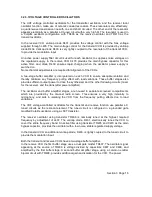
The action of this power control loop is to stabilize the output power for a normally matched
load.
For a load mismatch condition at the transmitter output, a standing wave will result which
causes a higher potential to appear at one end of the quarter-wave transmission section. This
will cause a higher detected feedback voltage for the same transmitter power setting. The
comparator will correct for this error and the result is a reduction in the output power.
Therefore, for most load mis-match conditions the transmitter is protected.The PTC resistor,
R579, senses the operating temperature of the transmitter. In the event of a temperature rise
above 100 deg C the PTC resistance will increase. This will cause a reduction of the control
loop reference voltage and will thereby reduce the transmitter output power, providing a
further measure of protection.
A second potentiometer, R578, is used to reduce the reference voltage when low power
operation is selected.
The output from the power amplifier is coupled to the antenna socket via a solid state antenna
changeover circuit and harmonic filter.
In the receive mode D439, D440 and D441 are all reverse biased through R600. The antenna
signal is coupled through to the receiver input. The reverse bias on D440 and D441 in the
receive mode ensures a minimum loading on the receiver input by the diodes.
In the transmit mode, +9V is applied to R596 which biases D439 on and couples the output
power to the antenna socket. The bias current for D439 flows into D440 and D441 via a PI-
section equivalent quarter-wave transmission line. Transistor TR428 is also biassed on, and
provides the ground return for diodes D440 and D441. Diodes D440 and D441 are biassed on
and form a short circuit across the receiver input to achieve isolation from the transmitter. This
short circuit is transformed to an effective open circuit by the action of the quarter-wave
transmission line PI section, and therefore does not load the transmitter output. A harmonic
rejection low pass filter is placed between the antenna changeover circuit and the antenna
socket.
At the output of the antenna changeover circuit, diode D442 which is loosely capacitively
coupled to the signal path, rectifies a small amount of the output power. This do voltage is
used to bias transistor TR424 on and provides the microprocessor with a signal to indicate
transmitter output.
3.2.2.1 VHF POWER AMPLIFIER
The VHF transmitter power amplifier is shown in block diagram form in figure 3.5.
The VHF power amplifier is based on a three-stage line-up utilizing discrete transistors in each
stage. The first stage, TR417, operates in class AB mode and amplifies the transmit VCO's
25mW output to approximately 250mW. This stage may have its gain varied by adjustment of
the bias voltage at the transistor base input. The second stage of amplification occurs in
TR419, operating in class C mode, to deliver up to 3 watts to the final amplifier TR422 which
also operates in class C. The output power from this stage is 30 watts to ensure
Section 3 Page 9






























